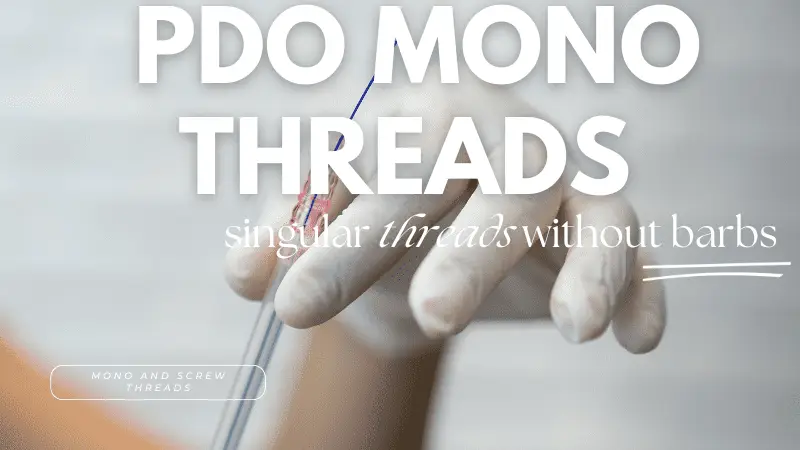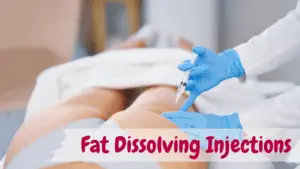PDO Threads
Certainly! PDO Threads is an exciting development in the world of non-surgical cosmetic procedures, offering significant skin rejuvenation and subtle lifting effects.
Polydioxanone (PDO) is a biodegradable synthetic polymer that has been used in medical suturing for years. The threads are safely reabsorbed into the body over a period of months, leaving behind improved skin texture and firmness.
PDO Mono Threads
PDO Mono Threads are smooth, singular threads without barbs or cones. These threads are inserted into the skin in a mesh-like pattern to provide a sort of scaffolding for the skin. This promotes the production of collagen, a protein vital to skin elasticity and firmness, over time.
The procedure with Mono Threads does not involve a dramatic lift but rather a gradual skin tightening effect and cellular renewal, thanks to collagen stimulation.
Mono Threads are perfect for fine lines, surface wrinkles, and subtle skin laxity. The results with Mono Threads are subtle and develop gradually over time.
PDO Screw Threads
Unlike Mono Threads, PDO Screw Threads have a spiral structure that allows for a more visible, immediate skin lift. As with the Mono Threads, Screw Threads also stimulate collagen production, offering a twofold benefit of immediate skin tightening and long-term skin rejuvenation.
PDO Screw Threads are typically used in areas where a little more volume or lift is needed, such as the nasolabial folds, lips, or even the cheeks.
Cog Threads
Cog threads are a specific type of PDO thread used in a non-surgical treatment known as a thread lift. They are named “cog” because of the tiny barbs or cogs that line the thread. These cogs provide a type of grip that hooks to the underside of the skin, providing a lifting and tightening effect.
When cog threads are inserted under the skin using a fine needle, the cogs catch onto the tissue, allowing the practitioner to create tension in the thread and lift the skin. This provides an immediate visible lifting effect.
In addition to the immediate lift, cog threads also stimulate collagen production, as the body heals around the PDO threads. This leads to firmer, younger-looking skin over time. As with mono and screw threads, cog threads are also biodegradable and will be safely absorbed by the body over a period of 6-8 months.
Cog threads are particularly effective in areas where significant lifting is desired, such as the cheeks, jawline, and neck.
Where on the body can threads be used?
PDO threads are quite versatile and can be used on various areas of the body. They’re primarily used for the face and neck, but practitioners have been exploring their use in other areas as well. Here are some common areas where PDO threads can be used:
- Face: This is the most common area for PDO threads. They can be used to lift sagging skin, reduce wrinkles, and improve skin texture in areas such as the forehead, eyebrows, cheeks, jowls, and around the mouth and eyes.
- Neck: PDO threads can help tighten loose skin and reduce the appearance of lines and wrinkles on the neck.
- Jawline: They can be used to provide a more defined jawline and reduce the appearance of jowls.
- Nose: PDO threads can be used for a non-surgical nose lift or to improve the nose’s shape.
- Chest/Decolletage: PDO threads can help improve skin texture and reduce wrinkles on the chest.
- Abdomen: They can be used to tighten loose skin, such as post-pregnancy or significant weight loss.
- Arms and Legs: PDO threads can also help tighten loose skin on the upper arms (often referred to as ‘bingo wings’) and thighs.
I would like to recommend to heed the effectiveness of PDO threads as they can vary depending on the area of the body and the individual’s skin condition.
How is the procedure performed?
Here’s a brief step-by-step overview:
- Preparation: The targeted area is thoroughly cleaned and sterilized. A local anesthetic is applied to numb the area and reduce discomfort.
- Thread Insertion: A thin needle or cannula containing the PDO thread is inserted into the skin. The practitioner guides the thread to the appropriate position and depth based on your specific treatment plan.
- Thread Positioning: Once the thread is in place, the needle is removed, leaving the thread behind. For cog threads, the practitioner may apply tension to lift the skin.
- Finishing Up: The procedure is repeated as needed based on the number of threads being used. After all threads are in place, the area is cleaned again.
As for the pain and discomfort, the use of local anesthesia helps to minimize this. You might feel some pressure or mild discomfort during the insertion of the threads, but severe pain is uncommon.
Aftercare advice
After a PDO thread lifts, it’s important to follow specific aftercare instructions to help your body heal and to maximize the results of the treatment.
Here are some general guidelines for what to do at home, things to avoid, and when to follow up:
At Home Care
- Ice Packs: Applying a cold compress or ice pack wrapped in a soft cloth to the treated areas can help to minimize swelling and bruising.
- Pain Management: If you experience discomfort, you can typically take over-the-counter pain relievers as your healthcare provider recommends.
- Skin Care: Keep the treated area clean and gently apply any prescribed creams or ointments. Continue with your normal skincare routine, but avoid harsh or abrasive products.
Things to Avoid
- Physical Strain: Avoid strenuous physical activity, including heavy lifting and vigorous exercise, for about a week following the procedure.
- Facial Movements: Try to limit excessive facial movements and expressions, and avoid massaging or rubbing the treated areas.
- Heat and Sun Exposure: Avoid sun exposure, tanning beds, saunas, and other forms of heat exposure for about a week after the procedure, as they can increase swelling.
- Alcohol and Smoking: Avoid alcohol for at least 24 hours post-procedure, as it can increase swelling and bruising. It’s also a good idea to avoid smoking, which can slow down the healing process.
Treatment Follow-Up
- Post-Treatment Checkup: Your practitioner will usually schedule a follow-up appointment about a week after your procedure to check your progress and address any concerns or complications.
- Long-Term Follow-Up: After this, you might have additional follow-ups at 3, 6, and 12 months post-procedure to assess the longevity of the results and discuss any further treatments.
Remember, these are general guidelines, and your practitioner might provide specific instructions tailored to your situation. Always follow your practitioner’s advice, and don’t hesitate to contact them if you have any questions or concerns or if you notice any unusual side effects.
How long before I see the effects?
The effects of PDO Threads become visible at different times, depending on the type of thread used and individual factors such as your skin type, age, and the area being treated.
If you’ve had a treatment using Cog Threads, which provide an immediate lift, you will see some effects right away. However, it’s important to note that there will likely be some swelling and bruising immediately after the procedure, which can temporarily affect the appearance of the results.
For Mono Threads and Screw Threads, which stimulate collagen production, the results develop gradually over time. You may start noticing an improvement in your skin’s texture, firmness, and overall appearance about 6-8 weeks after your procedure. This is about the time it takes for your body to start producing new collagen in response to the threads.
For all types of PDO Threads, the full effects are typically seen 3-6 months after the procedure, as the threads are absorbed by your body and new collagen is produced. The results can last anywhere from 6 months to 2 years, depending on individual factors.
As with any cosmetic procedure, individual experiences and results can vary, so it’s important to have realistic expectations and discuss your specific goals with your practitioner before undergoing treatment.
How long does this treatment last?
The longevity of PDO Thread treatments can vary depending on several factors such as the type of threads used, the area treated, and individual patient characteristics.
Generally, the threads themselves dissolve naturally in the body over a period of 6-8 months. However, during this time, they stimulate the production of collagen, which continues even after the threads have dissolved.
The beneficial effects of PDO Threads, including skin tightening and rejuvenation, can typically last anywhere from 6 months to 2 years. The results can last longer with a good skincare regimen, a healthy lifestyle, and avoiding factors that contribute to premature skin aging, such as sun exposure and smoking.
It’s worth noting that, as a non-surgical treatment, the results of a PDO Thread lift are not permanent. Over time, the natural aging process will continue, and skin laxity may return. For sustained results, many patients choose to have additional treatments after the effects of the first treatment have worn off.
How often will I need treatments?
The frequency of PDO thread treatments can depend on several factors, such as the type of threads used, the specific area treated, and your individual body’s response to the treatment.
Generally speaking, the effects of a PDO Thread treatment can last anywhere from 6 months to 2 years. Once the threads have been absorbed by the body and the collagen-stimulating effects have peaked, you may see the skin returning to its pre-treatment state gradually.
Therefore, if you wish to maintain the results of your PDO thread lift, you might consider having additional treatments every 1-2 years. However, this can vary depending on your personal goals, the initial results, and the advice of your healthcare provider.
Please note that it’s essential to consult with a qualified healthcare professional for personalized advice. They can assess your skin’s condition, discuss your aesthetic goals, and design a treatment plan that best suits your needs.
The Consultation
Skincare prep before the consult
Before your PDO thread lifts consultation, it can be beneficial to prepare your skin to be in the best possible condition. This is not a requirement, but a healthy skin environment might improve your outcomes and may even enhance healing after the procedure. Here are some skincare preparation steps you can consider:
- Healthy Routine: Maintain a regular skin care regimen that includes cleansing, toning, moisturizing, and applying sunscreen. This will help keep your skin clean, hydrated, and protected from sun damage.
- Nutrition: Nutrition plays a vital role in skin health. Ensure your diet is rich in antioxidants, vitamins, and minerals. Eating a variety of fruits, vegetables, lean proteins, and healthy fats can help improve your skin’s overall health and ability to heal.
- Hydration: Drink plenty of water to keep your skin hydrated from the inside. Dehydrated skin can delay the healing process and might not respond optimally to treatments.
- Avoid Harsh Products: Avoid using harsh skincare products or treatments in the weeks leading up to your consultation. This includes chemical peels, abrasive scrubs, or retinoid products, which could potentially irritate or sensitize your skin.
- Avoid Sun Damage: Minimize your sun exposure and always wear broad-spectrum sunscreen. Sun damage can make your skin more sensitive and might affect the healing process after the procedure.
During the consultation, your practitioner will evaluate your skin’s condition, discuss your aesthetic goals, and determine if PDO threads are the right treatment for you. They may also provide additional advice on how to prepare your skin before the procedure.
Please remember that while these are general tips, it’s essential to follow the specific advice provided by your healthcare professional.
What happens in the consultation?
The consultation for a PDO thread lift is a critical first step. This is where you discuss your aesthetic goals, and the practitioner assesses your suitability for the procedure. Here’s generally what you can expect during a PDO thread lift consultation:
- Medical History Review: Your practitioner will review your medical history, including any current or past health conditions, allergies, previous surgeries or treatments, and medications or supplements you are taking. This helps them understand any factors that might affect the treatment or recovery process.
- Skin Assessment: The practitioner will examine your skin, focusing on its tone, texture, elasticity, and any areas of concern. This assessment helps determine the best treatment approach for your specific needs.
- Discussion of Goals and Expectations: You’ll have the opportunity to discuss your aesthetic goals and expectations from the treatment. The practitioner will explain what results you can realistically expect given your skin condition and age.
- Explanation of the Procedure: The practitioner will explain the PDO thread lift procedure in detail, including the types of threads that might be used, the areas of the face or body that can be treated, the steps involved in the procedure, and what kind of aftercare will be required.
- Risk and Complications: It’s important to understand that all procedures come with potential risks and complications. Your practitioner will discuss these in detail so you can make an informed decision.
- Personalized Treatment Plan: Based on your skin assessment and discussion, the practitioner will develop a personalized treatment plan. This plan will include details like the number of treatments you might need, the type of threads to be used, and the specific areas to be treated.
- Costs and Logistics: Finally, you’ll receive information about the cost of the procedure, payment options, and scheduling details.
Remember, a consultation is your opportunity to ask any questions or express any concerns you might have. It’s important to leave feeling well-informed and comfortable with the next steps.
What are the side effects?
While PDO thread lifts are considered safe procedures, like all treatments, they can have potential side effects. Here are some you might experience:
- Swelling and Bruising: Some swelling and bruising are common in the treated area following the procedure. These effects typically diminish within a few days to a week.
- Pain and Discomfort: You may experience some pain, discomfort, or tenderness at the treatment site, particularly in the first few days following the procedure. Over-the-counter pain relievers can often help manage this discomfort, but be sure to consult with your practitioner before taking any medication.
- Skin Irregularities: Some patients might notice temporary dimpling, puckering, or pulling of the skin. These side effects usually resolve within a few weeks.
- Infection: Although rare, there is a risk of infection any time the skin is broken. It’s important to follow all post-procedure care instructions and to contact your practitioner if you notice any signs of infection, such as increased redness, swelling, pain, or pus.
- Thread Misplacement: In some cases, threads might not be positioned correctly, leading to asymmetry, visible threads under the skin, or a less-than-optimal lifting effect. An experienced practitioner is less likely to encounter these issues, and if they do occur, they can often be addressed by adjusting or replacing the threads.
- Nerve Damage: This is a rare but serious side effect. If the needle accidentally injures a nerve during the procedure, it could cause temporary or even permanent damage. This could lead to weakness, numbness, or changes in sensation.
Remember that everyone’s experience can be different, and the severity and duration of side effects can vary based on individual factors and the specifics of the procedure
FAQs
How long before I see the effects?
While you may see some immediate lift due to the physical pulling of the threads, the more pronounced and longer-lasting effects develop over time as the body produces new collagen in response to the presence of the PDO threads. The complete effects of the treatment can usually be seen about 6 weeks to 3 months after the procedure, once the collagen has had time to develop and mature. Please remember that individual experiences may vary based on personal health, the area treated, and the type of threads used.
How long does this treatment last?
The effects of a PDO thread lift treatment typically last between 6 months to 2 years. Generally, the threads themselves dissolve naturally in the body over a period of 6-8 months. However, during this time, they stimulate the production of collagen, which continues even after the threads have dissolved.
Does the treatment hurt?
A PDO thread lift procedure involves local anesthesia, which significantly minimizes pain and discomfort. You may feel some pressure or mild discomfort during the insertion of the threads, but severe pain is not common. Post-procedure, there might be some tenderness or soreness in the treated area, typically managed with over-the-counter pain relievers.
Will I be sore after my treatment?
Yes, it’s common to experience some soreness and tenderness in the treated area after a PDO thread lift. This is a normal healing process and typically subsides within a few days. If discomfort persists or intensifies, it is important to contact your healthcare provider.
Will I still be able to move my face?
Yes, you’ll still be able to move your face after a PDO thread lift. However, immediately after the procedure, your facial movements might feel a bit restricted due to swelling and the initial tightness from the lift. Your facial movements should return to normal as your body adjusts to the threads and the swelling subsides. It’s important to remember that PDO threads are designed to provide a natural-looking lift and rejuvenation, not to restrict your facial expressions or movement.
Is there any downtime?
The PDO thread lift is often referred to as a “lunchtime lift” due to its minimal downtime. One can return to their regular daily activities within a few days. However, there may be some visible signs of the treatment like minor swelling, bruising, or redness for the first few days. It is generally recommended to avoid strenuous exercise, heavy lifting, and other activities that could strain your face for about a week after the procedure. The specific downtime can vary depending on individual factors, so it’s best to discuss this with your healthcare provider.
Can I wear make-up afterward?
Generally, it is recommended to avoid applying makeup for at least 24 to 48 hours after a PDO thread lift procedure. This allows the tiny puncture sites where the threads were inserted to fully heal and reduce the risk of infection. After this initial period, you can usually return to your regular makeup routine. However, it is always best to follow the specific aftercare instructions provided by your healthcare provider.
Is this treatment safe?
Yes, PDO thread lifts are generally considered safe. The threads used in the procedure are made of a biocompatible material that has been used in medical procedures, including surgery, for many years. Additionally, because it is a minimally invasive procedure, the risks, and potential complications are significantly lower than those associated with surgical facelifts.
What are the side effects of this treatment?
While PDO threads are generally safe and effective, they can have potential side effects including infection, bruising, swelling, tenderness, and the possibility of the threads becoming visible under the skin or migrating from their original position. Very rarely, if the threads are placed incorrectly, they could damage a nerve, causing temporary or permanent issues.
Can I have this treatment at the same time as other treatments?
PDO thread can often be combined with other non-surgical aesthetic treatments, but the decision will depend on what specific treatments are being considered, the areas being treated, and your overall health status.
Treatments like dermal fillers and anti-wrinkle injections can complement PDO threads by addressing different aspects of facial aging. These treatments might be administered in the same session as the thread lift or in separate sessions spaced a few weeks apart.
While combining treatments can sometimes enhance overall results, it may also increase the risk of side effects or complications.
What happens if I stop this treatment?
If you decide to stop treatment, there will be no abrupt or negative effects. The threads themselves are made of a biodegradable material that is naturally broken down and absorbed by your body over a period of 6-8 months.
Unlike some treatments, there is no rebound or worsening of skin condition after the effects of PDO threads wear off. However, many people opt for periodic maintenance treatments to maintain the lifted, youthful appearance that PDO threads can provide.
Who is unsuitable for this treatment?
PDO threads are generally safe and suitable for many individuals. However, it is not recommended for those who are pregnant or breastfeeding, have active skin infections or inflammatory conditions, have blood disorders or bleeding disorders, take immunosuppressive medications or have immunosuppressive conditions, or have unrealistic expectations.
What alternative treatments are available?
Alternative treatments for those unsuitable for PDO threads or seeking different approaches include dermal fillers, Botulinum Toxin injections, laser skin resurfacing, chemical peels, microdermabrasion, and Ultherapy.
The best option depends on individual concerns, skin conditions, and desired outcomes.
How many threads are used for each area?
The number of threads used for each area varies based on factors like treatment goals, the area being treated, and individual needs. Your healthcare provider will determine the appropriate number during the consultation, considering your skin condition and desired outcome. Trust their expertise for personalized treatment planning.




